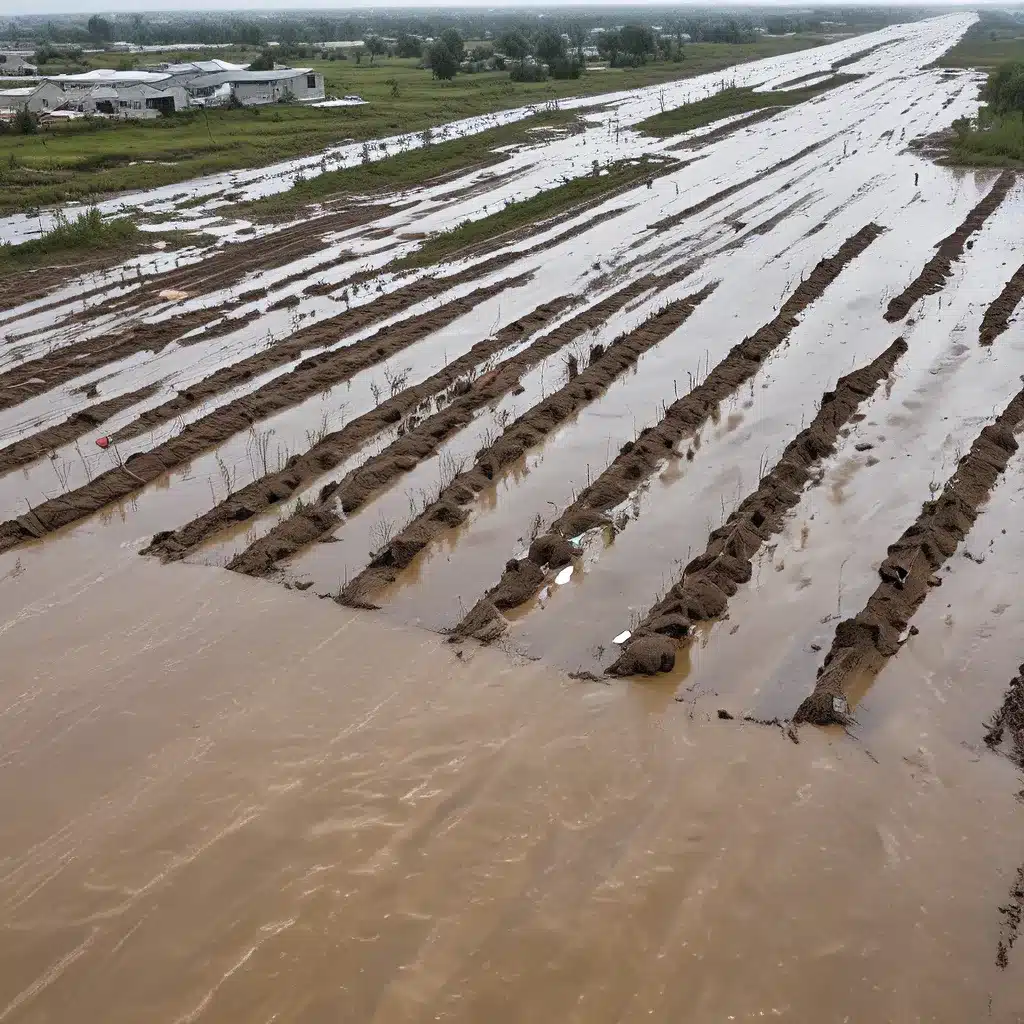
When natural disasters strike, the challenges we face can seem overwhelming. Torrential rains, powerful winds, and raging floodwaters can devastate communities, leaving behind a trail of destruction that feels almost impossible to overcome. But as I’ve learned, even in the midst of these harrowing events, there are glimmers of hope – innovative solutions that can help us weather the storm and emerge stronger than before.
Confronting the Water Crisis
It’s no secret that water is the lifeblood of our planet. When natural disasters disrupt the delicate balance of our water systems, the consequences can be dire. Flooded streets, contaminated groundwater, and damaged infrastructure all contribute to a perfect storm of water-related challenges.
As the California Water Boards explain, storm water – the runoff generated by rain and snowmelt – can act as both a nuisance and a resource. When it flows over land and impervious surfaces, it can mobilize pollutants like motor oil and trash, contributing to the pollution of our waterways. But when properly managed, storm water can also recharge groundwater and become a valuable asset.
Navigating this duality is crucial, especially in the face of extreme weather events. The Clean Water Act requires compliance with National Pollutant Discharge Elimination System (NPDES) permits to regulate stormwater discharges, but the reality is that these systems can be quickly overwhelmed during a crisis.
Harnessing the Power of Collaboration
In the aftermath of a disaster, the need for a coordinated response becomes paramount. As the experience with Hurricane Beryl in the Caribbean demonstrated, seamless coordination and real-time information sharing between local, state, and federal agencies, as well as international aid organizations, can make all the difference in minimizing loss and accelerating recovery efforts.
But the key to effective emergency response doesn’t just lie in the hands of first responders and government agencies. It also requires the collective efforts of communities, businesses, and environmental organizations. By fostering a spirit of collaboration and leveraging the expertise of diverse stakeholders, we can develop innovative solutions that address the unique water-related challenges posed by natural disasters.
Investing in Resilient Infrastructure
One of the most critical aspects of weathering the storm is ensuring that our infrastructure is prepared to handle the pressures of extreme weather events. This means going beyond traditional approaches and embracing innovative technologies and strategies that can withstand the rigors of a disaster.
As the City of New York’s report on combating extreme weather highlights, initiatives like green infrastructure, which utilizes natural systems to manage stormwater, can play a crucial role in reducing the risk of flooding and water contamination. By incorporating features like permeable pavements, rain gardens, and green roofs, we can create urban environments that are more resilient and better equipped to handle the challenges posed by environmental disasters.
But the investment in resilient infrastructure doesn’t stop there. Wastewater treatment plants, water distribution networks, and other critical water systems must also be strengthened to withstand the impacts of extreme weather. This may involve upgrading facilities, implementing redundancy measures, and exploring alternative water sources to ensure a reliable supply even when traditional sources are disrupted.
Embracing Innovation and Technology
As we navigate the uncharted waters of environmental disasters, the role of innovation and technology cannot be overstated. From real-time monitoring systems that provide critical data to decision-makers, to mobile water purification units that can be deployed in crisis situations, the tools and technologies at our disposal are constantly evolving.
One example that has captured my attention is the development of portable, self-powered water treatment systems. These compact, modular units can be quickly transported to affected areas and used to produce clean drinking water from even the most contaminated sources. By leveraging the power of renewable energy and advanced filtration techniques, these innovative solutions can provide a lifeline to communities in the midst of a crisis.
Another promising area of innovation lies in the realm of water reclamation and reuse. Companies like Inland Waters Inc. are pioneering technologies that can transform wastewater into a valuable resource, reducing the strain on traditional water supplies and minimizing the environmental impact of water-related disasters.
Fostering Preparedness and Resilience
While the thought of facing a natural disaster can be daunting, the truth is that with the right mindset and the right tools, we can emerge from these challenges stronger and more resilient than ever before. It’s all about cultivating a culture of preparedness and embracing the power of innovation.
One key aspect of this is education and outreach. By empowering communities with the knowledge and resources to understand the risks they face and the steps they can take to mitigate them, we can foster a sense of collective responsibility and resilience. This could involve everything from disaster response training to public awareness campaigns that highlight the importance of water conservation and stormwater management.
But preparedness is not just about individual or community-level action. It also requires a concerted effort at the organizational and governmental levels. This means investing in robust emergency management systems, developing comprehensive disaster response plans, and ensuring that the necessary resources and personnel are in place to respond effectively when disaster strikes.
Weathering the Storm Together
As I reflect on the challenges we face in the wake of environmental disasters, I’m struck by the resilience and ingenuity of the human spirit. Time and time again, we have proven our ability to adapt, innovate, and come together in the face of adversity.
The path forward may not be easy, but I’m confident that by harnessing the power of collaboration, embracing innovative solutions, and fostering a culture of preparedness, we can weather the storm and emerge stronger than ever before. It’s a journey that we must undertake together, as a global community united in our commitment to protecting our most precious resource – water.
So let’s roll up our sleeves, dive in, and start building a more resilient future. Because when the next disaster strikes, I want us to be ready.


